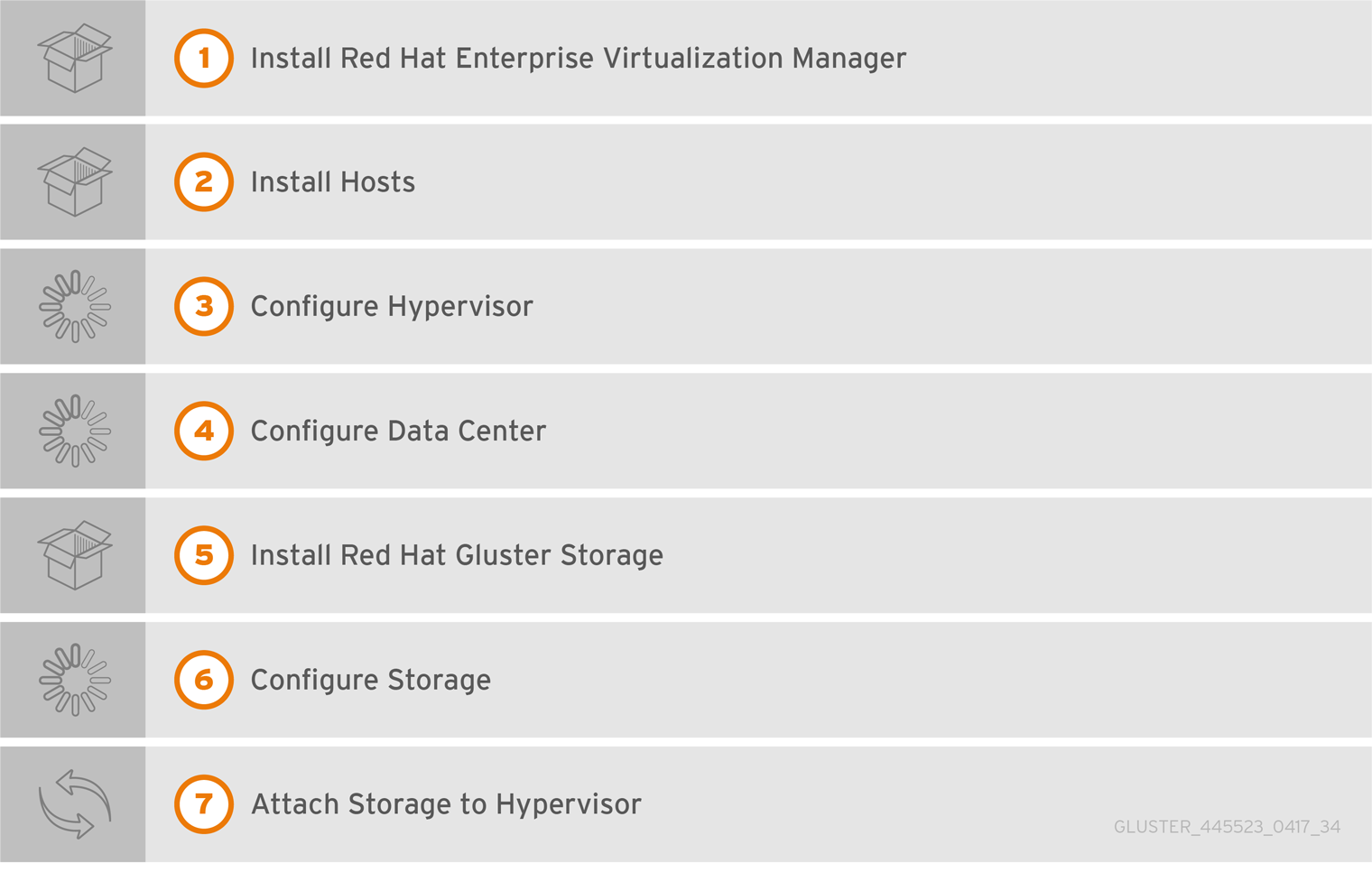Chapter 3. Enabling Red Hat Gluster Storage in Red Hat Virtualization Manager
3.1. Using Red Hat Gluster Storage Volumes in the Red Hat Virtualization Manager
Red Hat Virtualization supports Red Hat Gluster Storage volumes as storage domains. Enabling Red Hat Gluster Storage volumes in Red Hat Virtualization Manager requires installation and configuration of several components to create a functioning virtualization environment. You must install and configure each component in the following order:

Figure 3.1. Installation Workflow
Procedure 3.1. To Enable Red Hat Gluster Storage in Red Hat Virtualization Manager
Install Red Hat Virtualization Manager
The Red Hat Virtualization Manager is the control center of the Red Hat Virtualization environment. Ensure that Red Hat Virtualization Manager is installed and configured.Install and configure Red Hat Virtualization Manager. See Installing the Red Hat Virtualization Manager in the Red Hat Virtualization Installation Guide for more information: https://access.redhat.com/documentation/en-us/red_hat_virtualization/4.3/html/installing_red_hat_virtualization_as_a_self-hosted_engine_using_the_cockpit_web_interface/installing_the_red_hat_virtualization_manager_she_cockpit_deploy.Install Hosts
Install the virtual machine hosts using either Red Hat Virtualization Hypervisor or Red Hat Enterprise Linux as hosts. Before beginning the installation process, ensure that all virtualization hosts meet the hardware requirements and that the installation of Red Hat Virtualization Manager is complete.You can use the following hypervisors as hosts:- Red Hat Virtualization Host 4.3
- Red Hat Enterprise Linux 7
During installation, set the fully qualified domain name (FQDN) and IP address for the server in order to avoid network conflicts. For information on installing the hypervisor, see Installing Hypervisor Hosts in the Red Hat Virtualization Installation Guide: https://access.redhat.com/documentation/en-us/red_hat_virtualization/4.3/html/installing_red_hat_virtualization_as_a_self-hosted_engine_using_the_cockpit_web_interface/installing_the_self-hosted_engine_deployment_host_she_cockpit_deploy#Installing_Red_Hat_Virtualization_Hosts_SHE_deployment_host.Note
You must install Red Hat Enterprise Linux 7 on a system to use it as a virtualization host in a Red Hat Virtualization environment. See Installing Red Hat Enterprise Linux Hosts in the Red Hat Virtualization Installation Guide for details: https://access.redhat.com/documentation/en-us/red_hat_virtualization/4.3/html/installing_red_hat_virtualization_as_a_self-hosted_engine_using_the_cockpit_web_interface/installing_hosts_for_rhv_she_cockpit_deploy#Red_Hat_Enterprise_Linux_hosts_SHE_cockpit_deploy.Subscribe hosts to channels or repositories
Red Hat Enterprise Linux hosts need to be registered and subscribed to a number of entitlements using either Subscription Manager or Red Hat Network Classic. For more information, see Enabling the Red Hat Virtualization Manager Repositories in the Red Hat Virtualization Installation Guide: https://access.redhat.com/documentation/en-us/red_hat_virtualization/4.3/html/installing_red_hat_virtualization_as_a_self-hosted_engine_using_the_cockpit_web_interface/installing_hosts_for_rhv_she_cockpit_deploy.Subscribe Red Hat Enterprise Linux 7 hosts to the channel listed below:- rhel-7-server-rpms
- rhel-7-server-rhv-4-mgmt-agent-rpms
For information on how to install native clients, see Installing Native Client in the Red Hat Gluster Storage Administration Guide: https://access.redhat.com/documentation/en-us/red_hat_gluster_storage/3.5/html/administration_guide/sect-native_client#Installing_Native_ClientConfigure the Hypervisor
- Red Hat Virtualization Hypervisor host
- Install Red Hat Virtualization Hypervisor 3.5 on bare metal. See Installing the Red Hat Virtualization Hypervisor chapter of the Red Hat Virtualization Installation Guide: https://access.redhat.com/documentation/en-us/red_hat_virtualization/4.3/html/installing_red_hat_virtualization_as_a_standalone_manager_with_local_databases/installing_hosts_for_rhv_sm_localdb_deploy
- Red Hat Enterprise Linux 7 host
- A Red Hat Enterprise Linux virtualization host must be registered and subscribed to a number of entitlements using either Subscription Manager, See Subscribing to Required Channels using Red Hat Subscription Manager in the Installing Red Hat Enterprise Linux Hosts chapter of the Red Hat Virtualization Installation Guide for more information.Subscribe to the Red Hat Gluster Storage Native Client from the Additional Services Channels to ensure the server has the latest clients installed:
#
yum install glusterfs-fuse glusterfsFor more information, see Installing Native Client in the Red Hat Gluster Storage Administration Guide: https://access.redhat.com/documentation/en-us/red_hat_virtualization/4.3/html/installing_red_hat_virtualization_as_a_standalone_manager_with_local_databases/installing_hosts_for_rhv_sm_localdb_deploy.
Configure the data centers
Define data centers and clusters to organize the virtualization hosts. The installation process creates a data center and associated cluster namedDefault.Note
A server can be a Red Hat Virtualization Hypervisor or a Red Hat Enterprise Linux host. A trusted storage pool requires a minimum of one storage host, and at least one active virtualization host is required to connect the system to a storage pool.Install Red Hat Gluster Storage
Install the latest version of Red Hat Gluster Storage on new servers, not the virtualization hosts.For more information on obtaining and installing the software, see the Red Hat Gluster Storage Installation Guide: https://access.redhat.com/documentation/en-us/red_hat_gluster_storage/3.5/html/installation_guide/chap-installing_red_hat_storage.If you want to configure combined virtualization hosts and storage servers, see the Red Hat Hyperconverged Infrastructure documentation: https://access.redhat.com/documentation/en-us/red_hat_hyperconverged_infrastructure_for_virtualization/1.6/html-single/deploying_red_hat_hyperconverged_infrastructure_for_virtualization/Configure Storage
Configure Red Hat Gluster Storage volumes as required by your use case, ensuring that you adhere to the Chapter 2, Support Requirements.Optimize your Red Hat Gluster Storage volumes for storing virtual machine images by following the instructions in Procedure 4.1, “Configuring Volumes Using the Command Line Interface”.Red Hat Virtualization uses a centralized storage system for virtual machine disk images. Before adding storage, ensure that you have a working Red Hat Virtualization Manager environment. You must be able to access the Administration Portal, and there must be at least one host connected with Up status.Attach Storage to Hypervisor
Check that you can access the Red Hat Virtualization Manager Administration Portal and that at least one virtualization host hasUpstatus before you continue.Create a new storage domain with aDatadomain function and theGlusterFSstorage type. For further information, see the Adding a Red Hat Gluster Storage Volume as a Storage Domain section in the Red Hat Virtualization Administration Guide: https://access.redhat.com/documentation/en-us/red_hat_virtualization/4.3/html-single/administration_guide/index#Adding_Red_Hat_Gluster_Storage
You can now create virtual machines and its disk images on the Red Hat Gluster Storage volumes by following the instructions in Section 4.2, “Configuring Virtual Machines on Red Hat Gluster Storage volumes using the Red Hat Virtualization Manager”.

